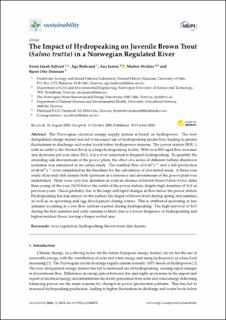| dc.contributor.author | Saltveit, Svein Jakob | |
| dc.contributor.author | Brabrand, Åge | |
| dc.contributor.author | Juarez, Ana | |
| dc.contributor.author | Stickler, Morten | |
| dc.contributor.author | Dønnum, Bjørn Otto | |
| dc.date.accessioned | 2021-01-15T14:08:19Z | |
| dc.date.available | 2021-01-15T14:08:19Z | |
| dc.date.created | 2020-10-20T11:31:50Z | |
| dc.date.issued | 2020 | |
| dc.identifier.citation | Saltveit, S. J., Brabrand, Å., Juárez, A., Stickler, M., & Dønnum, B. O. (2020). The Impact of Hydropeaking on Juvenile Brown Trout (Salmo trutta) in a Norwegian Regulated River. Sustainability, 12(20), 8670. | en_US |
| dc.identifier.issn | 2071-1050 | |
| dc.identifier.uri | https://hdl.handle.net/11250/2723315 | |
| dc.description.abstract | The Norwegian electrical energy supply system is based on hydropower. The now deregulated energy market has led to increased use of hydropeaking production, leading to greater fluctuations in discharge and water levels below hydropower stations. The power station HOL 1, with an outlet to the Storåne River, is a large hydropeaking facility. With over 300 rapid flow increases and decreases per year since 2012, it is a river subjected to frequent hydropeaking. To quantify the stranding risk downstream of the power plant, the effect of a series of different turbine shutdown scenarios was simulated in an earlier study. The residual flow of 6 m3·s−1 and a full production of 66 m3·s−1 were considered as the baselines for the calculation of dewatered areas. A three-year study of juvenile fish density both upstream as a reference and downstream of the power plant was undertaken. There were very low densities or even an absence of brown trout (Salmo trutta) older than young-of-the-year (YoY) below the outlet of the power station, despite high densities of YoY in previous years. This is probably due to the large and rapid changes in flow below the power station. Hydropeaking has less impact on the earliest life stages of brown trout during spring and summer, as well as on spawning and egg development during winter. This is attributed spawning in late autumn occurring at a low flow seldom reached during hydropeaking. The high survival of YoY during the first summer and early autumn is likely due to a lower frequency of hydropeaking and higher residual flows, leaving a larger wetted area. | en_US |
| dc.language.iso | eng | en_US |
| dc.rights | Navngivelse 4.0 Internasjonal | * |
| dc.rights.uri | http://creativecommons.org/licenses/by/4.0/deed.no | * |
| dc.title | The impact of hydropeaking on juvenile brown trout (Salmo trutta) in a Norwegian regulated river | en_US |
| dc.type | Peer reviewed | en_US |
| dc.type | Journal article | en_US |
| dc.description.version | publishedVersion | en_US |
| dc.rights.holder | © 2020 by the authors. | en_US |
| dc.source.volume | 12 | en_US |
| dc.source.journal | Sustainability | en_US |
| dc.source.issue | 20 | en_US |
| dc.identifier.doi | https://doi.org/10.3390/su12208670 | |
| dc.identifier.cristin | 1840822 | |
| dc.source.articlenumber | 8670 | en_US |
| cristin.ispublished | true | |
| cristin.fulltext | original | |
| cristin.qualitycode | 1 | |

